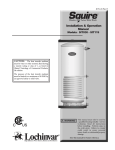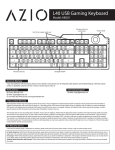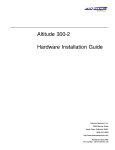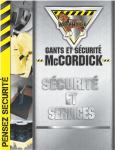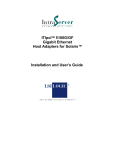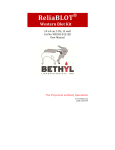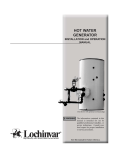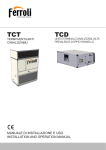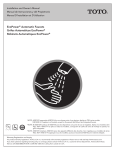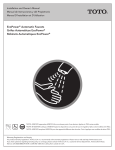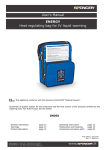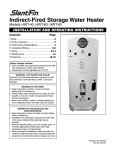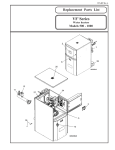Download Lochinvar SDT/SET065 User's Manual
Transcript
SDT-SET-I-O Rev C Installation & Operation Manual Models: SDT/SET065 - 119 CAUTION: The heat transfer medium must be water or other nontoxic fluid having a toxicity rating or class of 1, as listed in Clinical Toxicology of Commercial Products, 5th edition. The pressure of the heat transfer medium must be limited to a maximum of 30 PSIG by an approved safety or relief valve. SDT Solar Dual Coil Tank SET Solar Electric Tank WARNING This manual must only be used by a qualified heating installer / service technician. Read all instructions before installing. Perform steps in the order given. Failure to comply could result in severe personal injury, death, or substantial property damage. Save this manual for future reference. Contents HAZARD DEFINITIONS . . . . . . . . . . . . . . . . . . . . . . . . . . 2 PLEASE READ BEFORE PROCEEDING . . . . . . . . . . . . 3 1. GENERAL INFORMATION Operating Restrictions . . . . . . . . . . . . . . . . . . . . . . . . . . . . 4 Single-Wall Heat Exchanger . . . . . . . . . . . . . . . . . . . . . . . 4 2. PRE-INSTALLATION Locating the Tank . . . . . . . . . . . . . . . . . . . . . . . . . . . . . . . 5 Recommended Clearances . . . . . . . . . . . . . . . . . . . . . . . . 5 3. BOILER SIDE PIPING (SDT MODELS) Zone with Circulator to Aquastat . . . . . . . . . . . . . . . . . . . . 6 Zone with Valve to Aquastat . . . . . . . . . . . . . . . . . . . . . . . 6 DHW Prioritization . . . . . . . . . . . . . . . . . . . . . . . . . . . . . . . 6 Multiple Tank Connections (Boiler Side) . . . . . . . . . . . . . . 6 Table 3A - 3B - Pressure Drop Charts . . . . . . . . . . . . . 7 Table 3C - Pressure Drop Values . . . . . . . . . . . . . . . . . 7 Piping Diagrams . . . . . . . . . . . . . . . . . . . . . . . . . . . . . . . . 8-11 4. DOMESTIC SIDE (TANK) PIPING Basic Domestic Piping . . . . . . . . . . . . . . . . . . . . . . . . . 11 Multiple Tank Domestic Water Piping . . . . . . . . . . . . . 11 Domestic Water Piping for Distant Fixtures . . . . . . . . .11 Anti-scald Valves (Mixing Valves) . . . . . . . . . . . . . . . . 12 Install Drain Valve . . . . . . . . . . . . . . . . . . . . . . . . . . . 12 Temperature and Pressure (T&P) Relief Valve . . . . . 12 Table 4A - Minimum Relief Valve (AGA Rating) . . 13 5. WIRING Electrical Connection and Thermostat Setup . . . . . . . . . .16 Indirect Water Heater Sensor Setup (Knight Boiler) . . . . 18 Install and Connect Tank Sensor . . . . . . . . . . . . . . . . . . . 18 Indirect Water Heater Controlled Using Aquastat and Zone Circulator . . . . . . . . . . . . . . . . . . . . . . . . . . . . . . . . . . . . . 19 6. START-UP AND CHECK-OUT . . . . . . . . . . . . . . . . . 20 7. MAINTENANCE Maintenance Schedule . . . . . . . . . . . . . . . . . . . . . . . . . . 21 To Fill the Water Heater . . . . . . . . . . . . . . . . . . . . . . . 21 To Drain the Water Heater . . . . . . . . . . . . . . . . . . . . . 21 8. PERFORMANCE DATA Performance Data Charts . . . . . . . . . . . . . . . . . . . . . . . . 22-24 9. High Output Piping High Domestic Hot Water Usage . . . . . . . . . . . . . . . . 25 Series Piping . . . . . . . . . . . . . . . . . . . . . . . . . . . . . . . 25-26 Parallel Piping. . . . . . . . . . . . . . . . . . . . . . . . . . . . . .25-27 REVISION NOTES . . . . . . . . . . . . . . . . . . . . . Back Cover Hazard definitions The following defined terms are used throughout this manual to bring attention to the presence of hazards of various risk levels or to important information concerning the life of the product. DANGER DANGER indicates an imminently hazardous situation which, if not avoided, will result in death or serious injury. WARNING WARNING indicates a potentially hazardous situation which, if not avoided, could result in death or serious injury. CAUTION indicates a potentially hazardous situation which, if not avoided, may result in minor or moderate CAUTION injury. CAUTION NOTICE 2 CAUTION used without the safety alert symbol indicates a potentially hazardous situation which, if not avoided, may result in property damage. NOTICE indicates special instructions on installation, operation, or maintenance that are important but not related to personal injury or property damage. SDT/SET Installation & Operation Manual Please read before proceeding WARNING NOTICE Installer – Read all instructions before installing. Perform steps in the order given. Have this indirect water heater serviced/inspected by a qualified service technician, at least annually. Failure to comply with the above could result in severe personal injury, death or substantial property damage. When calling or writing about the appliance – Please have the indirect water heater model and serial number from the indirect water heater rating plate. Consider piping and installation when determining appliance location. Any claims for damage or shortage in shipment must be filed immediately against the transportation company by the consignee. Factory warranty (shipped with appliance) does not apply to appliances improperly installed or improperly operated. WARNING If the information in this manual is not followed exactly, a fire or explosion may result causing property damage, personal injury or loss of life. This appliance MUST NOT be installed in any location where gasoline or flammable vapors are likely to be present. WHAT TO DO IF YOU SMELL GAS • Do not try to light any appliance. • Do not touch any electric switch; do not use any phone in your building. • Immediately call your gas supplier from a neighbor’s phone. Follow the gas supplier’s instructions. • If you cannot reach your gas supplier, call the fire department. • Installation and service must be performed by a qualified installer, service agency, or the gas supplier. WARNING Failure to adhere to the guidelines on this page can result in severe personal injury, death, or substantial property damage. When servicing the indirect water heater – • To avoid severe burns, allow the appliance to cool before performing maintenance. Indirect water heater operation – • Should overheating occur or gas supply fail to shut off, do not turn off or disconnect electrical supply to circulator. Instead, shut off the gas supply at a location external to the appliance. • Do not use this appliance if any part has been under water. The possible damage to a flooded appliance can be extensive and present numerous safety hazards. Any appliance that has been under water must be replaced. The following chart details the relationship of water temperature and time with regard to scald injury and may be used as a guide in determining the safest water temperature for your applications. APPROXIMATE TIME / TEMPERATURE RELATIONSHIPS IN SCALDS 120°F More than 5 minutes 125°F 1 1/2 to 2 minutes 130°F About 30 seconds 135°F About 10 seconds 140°F Less than 5 seconds 145°F Less than 3 seconds 150°F About 1 1/2 seconds 155°F About 1 second Hot Water Can Scald! • Water heated to temperatures for clothes washing, dish washing, and other sanitizing needs can scald and cause permanent injury. • Children, elderly, and infirm or physically handicapped persons are more likely to be permanently injured by hot water. Never leave them unattended in a bathtub or shower. Never allow small children to use a hot water tap or draw their own bath. • If anyone using hot water in the building fits the above description, or if state laws or local codes require certain water temperatures at hot water taps, you must take special precautions: • Use lowest possible temperature setting. • Install some type of tempering device, such as an automatic mixing valve, at hot water tap or water heater. Automatic mixing valve must be selected and installed according to valve manufacturer’s recommendations and instructions. • Water passing out of drain valves may be extremely hot. To avoid injury: • Make sure all connections are tight. • Direct water flow away from any person. Protection Must Be Taken Against Excessive Temperature and Pressure! --Installation of a Temperature & Pressure (T&P) relief valve is required. 3 SDT/SET Installation & Operation Manual 1 General Information The Lochinvar SDT/SET series indirect water heater (FIG. 1-1) is designed to generate domestic hot water in conjunction with a solar panel using forced circulation with a backup heat source. This indirect water heater consists of a 316L Stainless Steel tank in which a smooth 304L stainless steel coil is located (Table 1A). Solar heating fluid is pumped through the coil and heats the water in the tank. If the solar panel cannot produce enough heat, the backup source should supply hot water. This tank is not intended for use in pool heating applications or for heating any fluid other than water. It is also not intended for use in gravity hot water heating systems. Single-Wall Heat Exchanger Operating Restrictions: • • • Uniform Plumbing Code Single-wall heat exchangers are permitted if they satisfy all of the following requirements -- Maximum domestic hot water temperature is 194°F. Maximum boiler water temperature is 210°F. Maximum working pressure for the vessel tank is 150 psig. 1. The heat transfer medium is potable water or contains only substances which are recognized as safe by the U.S. Food and Drug Administration. 2. The pressure of the heat transfer medium is maintained less than the normal minimum operating pressure of the potable water system. 3. The equipment is permanently labeled to indicate that only additives recognized as safe by the FDA shall be used in the heat transfer medium. Other heat exchanger designs may be permitted where approved by the Administrative Authority. Table 1A Component Materials Component Material Tank 316L Steel Stainless Steel Coil 304L Stainless Steel Insulation Polyurethane Jacket Polypropylene / ABS Figure 1-1 Lochinvar SDT and SET Series Indirect Water Heaters 1. RELIEF VALVE CONNECTION PART NO. 2. HOT WATER OUTLET 3. BOILER WATER IN SDT065 4. BOILER WATER OUT SDT080 5. DRAIN / COLD WATER INLET SDT119 SET065 6. SOLAR WATER IN SET090 7. SOLAR WATER OUT SET119 8. ELEMENT “A” (in.) 3 5/16 3 5/16 3 5/16 3 5/16 3 5/16 3 5/16 “B” (in.) 9 1/8 9 1/8 9 3/8 9 1/8 9 1/8 9 3/8 “E” “C” “D” (in.) (in.) (in.) 27 15/16 33 5/8 47 3/16 27 15/16 40 3/16 53 3/4 31 11/16 37 7/16 54 1/2 N/A N/A 27 15/16 N/A 27 15/16 N/A N/A 31 11/16 N/A “F” (in.) 52 5/16 61 13/16 60 1/8 52 5/16 61 13/16 60 1/8 “G” (in.) 59 7/8 69 3/8 68 3/16 59 7/8 69 3/8 68 3/16 “H” (in.) N/A N/A N/A 59 7/8 59 7/8 59 7/8 SOLAR ELECTRIC o 45 820 921 1268 820 921 1268 o 22.5 o 22.5 FULL OF WATER (LBS) “I” “I” SOLAR DUAL COIL WEIGHT “I” (in.) 24 24 28 24 24 28 1 - 1/2” FPT 2 3/4” FPT o 45 1 - 1/2” FPT 2 1 3/4” FPT 1 AQUASTAT WELL 1” MPT 1” MPT 8 1” MPT 1” MPT 6 “G” 6 “G” “F” SOLAR SENSOR “E” “F” SOLAR SENSOR “H” “D” “C” 1” MPT 7 1” MPT “C” 1 - 1/2” MPT 5 “B” “A” 4 1” MPSF 8 3 7 1 - 1/2” MPT 5 “B” “A” SDT/SET Installation & Operation Manual 2 1. 2. Pre-installation The installation must conform to the instructions in this manual and all applicable local, state, provincial, and national codes, laws, regulations, and ordinances. Installations in Canada must conform to B149.2 Installation Code. 1. Choose a location for your water heater centralized to the piping system. You must also locate the SDT/SET water heater where it will not be exposed to freezing temperatures. Additionally, you will need to place the water heater so that the controls, drain, and inlet/outlets are easily accessible. This appliance must not be installed outdoors, as it is certified as an indoor appliance, and must also be kept vertical on a level surface. 2. Keep distance between boiler and water heater to a minimum to: a. reduce piping heat loss b. provide minimal friction loss 3. Figure 1-1 on page 4 shows the weights of all the tanks filled with water. Make sure that the location chosen for the tank is capable of supporting it. Be certain the domestic water supply to the tank has physical and chemical characteristics that fall within the limits shown in Table 2A. Where questions exist as to the composition of the water on the job, a qualified water treatment expert should be consulted. Water with characteristics outside the limits shown in Table 2A may severely shorten the life of the tank due to corrosion. Damage to tanks in such cases is not covered under warranty. CAUTION 3. Locating the Tank Read and understand all installation requirements in this manual. CAUTION Table 2A Water Chemistry Requirements Water used in the tank must have characteristics falling within the following limits: Characteristic Min. Max. Ph 6.0 8.0 Chloride (PPM) -- 80 Figure 2-1 Element Cover Clearances 4. This appliance must be placed where leakage from the relief valve, leakage from the related piping, or leakage from the tank or connections, will not result in damage to the surrounding areas, or to the lower floors of the building. A water heater should always be located in an area with a floor drain or installed in a drain pan suitable for water heaters. Lochinvar shall not be held liable for any such water damage. The tank may be located some distance from the boiler provided the pump is designed to provide the flow called for in Table 3B (page 7)- Pressure Drop Values, through the coil. The further the tank is from the boiler, the longer the response of the boiler will be to a call from the tank zone. Insulate piping between the boiler and the tank. WARNING Failure to properly support the tank could result in property damage or personal injury. Recommended Clearances 24” MIN CLEARANCE FROM ELEMENT COVER (SET Models) The installation location must provide adequate clearances for servicing and proper operation of the water heater. A 12 inch vertical clearance is recommended from the top of the water heater. A zero clearance is allowed for the sides of the water heater. However, boiler, electrical, and servicing clearances must be figured when locating the water heater. Minimum Clearance to the Element Cover See FIG 2-1. Clearances must be a minimum of 24-inches to allow for element removal and replacement on SET model. 5 SDT/SET Installation & Operation Manual 3 Boiler Side Piping (SDT models) Figures 3-1 thru 3-4 show typical boiler side piping for several common situations. Regardless of which system is used it is imperative that the flow rates called for in Table 3C are developed through the coil. This requires properly sized piping and a properly sized pump. The system shown in FIG’s 3-1 thru 3-4 are described below: Zone with Circulator to Aquastat This system is like the circulator zone system on a straight heat job except that one of the zones goes to the tank instead of radiation. As on any circulator zone system check valves should be installed in each zone to prevent unwanted circulation through zones which are not calling for heat. Figure 3-1 on page 8 illustrates typical circulator zone piping. Zone with Valve to Aquastat As with the circulator zone system, this system is just like a standard heating zone system except that one of the zones is connected to the tank coil as shown in FIG. 3-2 on page 9. The system circulator must be large enough to move boiler water through the coil regardless of the flow rate required through the heating zones. DHW Prioritization This piping system is designed to provide direct hot water priority over the other zones in the heating system. When there is a Domestic Hot Water (DHW) call for heat, the Knight control will shut off the boiler circulator and activate the domestic hot water circulator. Once the DHW demand is satisfied, the boiler circulator will be readjusted as demand requires. The circulator must be large enough to move the boiler water through the coil in the tank, and it must meet the minimum boiler flow requirments. The recommended piping for a DHW priority system is depicted in FIG. 3-3 on page 10. 6 Multiple Tank Connections (Boiler Side) Multiple tank installations must be done in the “reverse-return” manner. The reason for this is to create the same pressure drop (and therefore, the same flow) through the coil of each tank. The boiler manifold piping must be sized so that each coil has the flow rate called for in Table 3B. Because the pressure drop through tank coils varies from size to size, it is hard to predict the flow rate that will be developed through each coil when two tanks of different sizes are placed in the same manifold. For this reason it is best not to mix tanks of different sizes in the same zone if their recovery is critical. SDT/SET Installation & Operation Manual 3 Boiler Side Piping (SDT models) Table 3A Pressure Drop Chart SDT/SET065-080 (continued) Table 3B Pressure Drop Chart SDT/SET119 Table 3A Pressure Drop Chart SDT/SET065-080 Table 3B Pressure Drop Chart SDT/SET119 SDT / SET065 - 080 FRICTION LOSS SDT / SET119 FRICTION LOSS 10.00 10.00 SOLAR COIL SOLAR COIL 12.00 10.00 8.00 8.00 BOILER BOILER COILCOIL 6.00 6.00 4.00 4.00 BOILER COIL 8.00 FT/HD FT/HD FT/HD SOLAR COIL 6.00 4.00 2.00 2.00 2.00 0 0.00 0.00 5 8 12 16 20 5 8 GPM 12 16 20 GPM Table 3C Pressure Drop Values SDT/SET065-119 Table 3C Pressure Drop Values MODEL COIL SQ FT COIL CONN. LENGTH SURFACE AREA (FT) (IN) PRESSURE DROP SOLAR COIL (FT / HD) COIL 5 GPM 8 GPM 12 GPM 16 GPM 20 GPM PRESSURE DROP BOILER COIL (FT / HD) SQ FT LENGTH SURFACE (FT) AREA 5 GPM 8 GPM 12 GPM 16 GPM 20 GPM SDT065 1 41.5 13.5 0.61 1.57 3.53 6.27 9.8 28 9.2 0.4 1.03 2.31 4.1 6.41 SDT080 1 41.5 13.5 0.61 1.57 3.53 6.27 9.8 28 9.2 0.4 1.03 2.31 4.1 6.41 SDT119 1 67.3 22.0 .73 1.87 4.22 7.5 11.71 48.5 16 0.61 1.57 3.53 6.27 9.8 SET065 1 41.5 13.5 0.61 1.57 3.53 6.27 9.8 SET080 1 41.5 13.5 0.61 1.57 3.53 6.27 9.8 SET119 1 67.3 22.0 .73 1.87 4.22 7.5 11.71 7 SDT/SET Installation & Operation Manual 3 Boiler Side Piping (SDT models) Figure 3-1 Piping Diagram Zoned with Circulators ZONE #1 PRESSURE REDUCING VALVE ZONE #2 PRESSURE GAUGE ZONE #3 ZONE #4 BACKFLOW PREVENTER ZONE CIRCULATORS (TYPICAL) MAKE UP WATER SYSTEM SUPPLY SENSOR (WHEN USED) AIR SEPARATOR EXPANSION TANK HOT WATER OUT NOT TO EXCEED 4 PIPE DIA. OR A MAXIMUM OF 12" APART DRAIN POINT (TYPICAL) ANTI-SCALD MIXING VALVE COLD WATER IN Y-STRAINER BALL VALVE (TYPICAL) BOILER CIRCULATOR TEMPERATURE/ PRESSURE RELIEF VALVE FLOW CHECK VALVE BOILER TANK SENSOR / AQUASTAT BOILER BACKUP HEAT EXCHANGER ( SDT MODELS ONLY ) SOLAR SENSOR CHECK VALVE TEMPERATURE/ PRESSURE GAUGE (TYPICAL) FROM SOLAR UNION (TYPICAL) TO SOLAR TEMPERATURE / PRESSURE GAUGE DRAIN PRESSURE RELIEF VALVE GAS SUPPLY SOLUTION BOILER SOLAR HEAT EXCHANGER RECIRCULATION PUMP SQUIRE CHECK VALVE DRAIN ( FIELD SUPPLY ) AUXILIARY CATCH PAN NOTICE NOTICE 8 Please note that these illustrations are meant to show system piping concept only, the installer is responsible for all equipment and detailing required by local codes. Please note that the installer is responsible for ensuring DHW prioritization when piped as a zone. Installation & Operation Manual 3 Boiler Side Piping (SDT models) (continued) Figure 3-2 Piping Diagram Zoned with Valves ZONE #1 ZONE #2 PRESSURE REDUCING VALVE PRESSURE GAUGE BACKFLOW PREVENTER MAKE UP WATER ZONE #4 ZONE #3 ZONE VALVES (TYPICAL) SYSTEM SUPPLY SENSOR (WHEN USED) DIFFERENTIAL PRESSURE BYPASS VALVE (IF USED) SYSTEM CIRCULATOR AIR SEPARATOR EXPANSION TANK HOT WATER OUT NOT TO EXCEED 4 PIPE DIA. OR A MAXIMUM OF 12" APART DRAIN POINT (TYPICAL) ANTI-SCALD MIXING VALVE COLD WATER IN Y-STRAINER BALL VALVE (TYPICAL) TEMPERATURE/ PRESSURE RELIEF VALVE BOILER CIRCULATOR BOILER BACKUP HEAT EXCHANGER ( SDT MODELS ONLY ) BOILER TANK SENSOR / AQUASTAT SOLAR SENSOR CHECK VALVE TEMPERATURE/ PRESSURE GAUGE (TYPICAL) FROM SOLAR UNION (TYPICAL) TO SOLAR TEMPERATURE / PRESSURE GAUGE DRAIN PRESSURE RELIEF VALVE GAS SUPPLY NOTICE NOTICE SOLUTION BOILER SOLAR HEAT EXCHANGER RECIRCULATION PUMP SQUIRE CHECK VALVE DRAIN ( FIELD SUPPLY ) AUXILIARY CATCH PAN Please note that these illustrations are meant to show system piping concept only, the installer is responsible for all equipment and detailing required by local codes. Please note that the installer is responsible for ensuring DHW prioritization when piped as a zone. 9 SDT/SET Installation & Operation Manual 3 Boiler Side Piping (SDT models) Figure 3-3 Knight Boiler Primary / Secondary Piping PRESSURE REDUCING VALVE BACKFLOW PREVENTER PRESSURE GAUGE MAKE UP WATER SYSTEM SUPPLY SENSOR AIR SEPARATOR TO SYSTEM BALL VALVE (TYPICAL) NOT TO EXCEED4 PIPE DIA. OR A MAXIMUM OF 12" APART SYSTEM CIRCULATOR FROM SYSTEM Y-STRAINER (RECOMMENDED) EXPANSION TANK BOILER CIRCULATOR DOMESTIC HOT WATER CIRCULATOR ANTI-SCALD MIXING VALVE HOT WATER OUT COLD WATER IN TEMPERATURE/ PRESSURE RELIEF VALVE DRAIN POINT (TYPICAL) BOILER BACKUP HEAT EXCHANGER (SDT MODELS ONLY) BOILER TANK SENSOR / AQUASTAT SOLAR SENSOR CHECK VALVE TEMPERATURE/ PRESSURE GAUGE (TYPICAL) FROM SOLAR TO SOLAR UNION (TYPICAL) TEMPERATURE / PRESSURE GAUGE DRAIN PRESSURE RELIEF VALVE NOTICE 10 KNIGHT BOILER SOLAR HEAT EXCHANGER SQUIRE RECIRCULATION PUMP CHECK VALVE DRAIN (FIELD SUPPLY) Please note that these illustrations are meant to show system piping concept only, the installer is responsible for all equipment and detailing required by local codes. SDT/SET Installation & Operation Manual 3 Boiler Side Piping (SDT models) (continued) Figure 3-4 Multiple Tank Connections PRESSURE REDUCING VALVE BACKFLOW PREVENTER MAKE UP WATER PRESSURE GAUGE AIR SEPARATOR SYSTEM SUPPLY SENSOR TO SYSTEM BALL VALVE (TYPICAL) NOT TO EXCEED 4 PIPE DIA. OR A MAXIMUM OF 12” APART SYSTEM CIRCULATOR FROM SYSTEM HOT WATER OUT Y-STRAINER (RECOMMENDED) SYSTEN CIRCULATOR EXPANSION TANK BOILER CIRCULATOR DOMESTIC HOT WATER CIRCULATOR ANTI-SCALD MIXING VALVE DRAIN POINT (TYPICAL) COLD WATER IN TEMPERATURE/ PRESSURE RELIEF VALVE BOILER TANK SENSOR/ AQUASTAT SOLAR SENSOR CHECK VALVE TEMPERATURE/ PRESSURE GAUGE (TYPICAL) FROM SOLAR TO SOLAR UNION (TYPICAL) DRAIN TEMPERATURE/ PRESSURE GAUGE PRESSURE RELIEF VALVE NOTICE RECIRCULATION PUMP KNIGHT BOILER SOLAR HEAT EXCHANGER (TYPICAL) SQUIRE SQUIRE CHECK VALVE (TYPICAL) DRAIN (FILED SUPPLIED) Please note that these illustrations are meant to show system piping concept only, the installer is responsible for all equipment and detailing required by local codes. 11 SDT/SET Installation & Operation Manual 4 Domestic Side (Tank) Piping Basic Domestic Piping Domestic Water Piping for Distant Fixtures Figure 4-2 on page 15 shows typical domestic water piping for a tank. The function of the components shown are as follows: In some cases the furthest fixture may be quite distant from the tank. Such an installation would result in an unacceptable delay before hot water reaches these distant fixtures. Even if all the fixtures are relatively close to the tank, the building owner may want hot water at all fixtures as soon as they are opened. a. Shut-off valves (recommended) - Used to isolate the tank for servicing. b. Backflow Preventer (required by some codes) - Used to prevent water from backing out of the tank and into the main potable water supply in the event that inlet water pressure drops. c. Expansion Tank (required for thermal expansion)- his expansion tank absorbs the increased volume caused by heating water. Use an expansion tank designed for use on domestic water systems. Refer to the expansion tank manufacturer’s literature for the proper size expansion tank to use. NOTICE When an expansion tank is used, do not put any valves between the expansion tank and tank inlet. d. Unions (recommended) - Used to disconnect the tank in the unlikely event that this is necessary. e. Drain (required) - Used to drain the tank for inspection or servicing. Multiple Tank Domestic Water Piping The two pipe reverse return piping uses more pipe than the two pipe direct return piping, but the flow is more balanced and even in the two pipe reverse return piping layout (see FIG. 3-4). Each tank must have its own T&P valve. It is recommended that each tank be equipped with its own isolation valves, unions, and drains so that one tank may be removed from the system. If local codes require a backflow preventer, check with the appropriate authority to find out whether one backflow preventer may be used for tanks or each tank must be equipped with its own backflow preventer. If each tank must have its own backflow preventer, each tank must also have its own expansion tank. If a common backflow preventer is permitted, an expansion tank must be sized to accommodate the expansion volume of all tanks. 12 To prevent delays, return circulation piping with a check valve that allows flow to the inlet of the tank. This should be installed on each branch circuit at the farthest fixture or device, so that hot water is supplied upon demand. Because hot water is always circulating in the hot water branch, the entire branch should be insulated to prevent excessive heat loss. SDT/SET Installation & Operation Manual 4 Domestic Side (Tank) Piping Anti-scald Valves (Mixing Valves) Anti-scald valves used with water heaters are also called tempering valves or mixing valves. An anti-scald valve mixes cold water in with the outgoing hot water to assure that hot water reaching a building fixture is at a temperature low enough to be safe. ASSE1017 and ASSE1070 certified valves are recommended. Usually, the maximum temperature of the outlet water will stay near the setting of the tank control. In some cases, however, hot water usage patterns can cause the outlet water temperature to rise significantly above the control setting. The temperature of water going to the fixtures may be more carefully controlled through the use of a thermostatic mixing valve. This device blends a controlled amount of cold water with the hot water leaving the tank so that water at a more constant temperature exits the mixing valve. Anti-scald mixing valve piping is illustrated in FIG.’s 3-1 thru 3-4. WARNING An anti-scald mixing valve does not eliminate the risk of scalding. * * * Set the tank thermostat as low as practical. Feel water before bathing or showering. If anti-scald or anti-chill protection is required, use devices specifically designed for such service. Install these devices in accordance with their manufacturer’s instructions. (continued) Temperature & Pressure (T&P) Relief Valve WARNING For protection against excessive temperatures and pressure, install temperature and pressure protective equipment required by local codes, but not less than a combination temperature and pressure relief valve certified by a nationally recognized testing laboratory that maintains periodic inspection of production of listed equipment or materials as meeting the requirements for Relief Valves and Automatic Gas Shutoff Devices for Hot Water Supply Systems, ANSI Z21.22 and the Standard CAN1-4.4, Temperature, Pressure, Temperature and Pressure Relief Valves and Vacuum Relief Valves. The combination temperature and pressure relief valve shall be marked with a maximum set pressure not to exceed the maximum working pressure of the water heater. The combination temperature and pressure relief valve shall also have an hourly rated temperature steam BTU discharge capacity not less than shown in Table 4A, page 14. Install the combination temperature and pressure relief valve into the opening provided and marked for this purpose on the water heater. Install Drain Valve Drain valve and fittings are supplied by others. Standard Installation • Install a tee connection at the domestic cold water inlet (FIG. 4-1). Figure 4-1 Drain Valve Installed DRAIN VALVE 13 SDT/SET Installation & Operation Manual 4 Domestic Side (Tank) Piping Verify that the combination temperature and pressure relief valve complies with local codes. If the combination temperature and pressure relief valve does not comply with local codes, replace it with one that does. Follow the installation instructions in this section. NOTICE Do not place a valve between the combination temperature and pressure relief valve and the tank. Determine T&P relief valve size by the following specifications, unless they conflict with local codes: - SDT/SET065/080/119 - 3/4" NPT with a minimum CSA Rating of 200,000 Btu/hr. NOTICE The Lochinvar SDT/SET series water heaters will absorb/store less than 200,000 Btu/hr when domestic water outlet temperature is 210°F and boiler water supply temperature is 240°F. Listed outputs are based on ASME Section VIII Interpretation VIII-1-86-136. Check with local codes for applicability. Table 4A Minimum Relief Valve (CSA Rating) 14 Model BTU/hr SDT/SET065 200,000 SDT/SET080 200,000 SDT/SET119 200,000 Standard Installation • Install the T&P relief valve in the connection marked “Relief Valve”. T&P Relief Valve Discharge Piping T&P relief valve discharge piping must be: - made of material serviceable for a temperature of 250°F or greater. - directed so that hot water flows away from all persons. - directed to a suitable place for disposal. - installed so as to allow complete draining of the T&P relief valve and discharge line. - terminated within 6" of the floor. T&P relief valve discharge piping must not be: - excessively long. Using more than two (2) elbows or 15 feet of piping can reduce discharge capacity. - directly connected to a drain. Refer to local codes. - subject to freezing. WARNING Do not install any valve between the T&P relief valve and the tank connection or on the T&P relief valve discharge piping. Improper placement and piping of T&P relief valve can cause severe personal injury, death or substantial property damage. CAUTION The T&P relief valve is not intended for constant duty, such as relief of pressure due to repeated normal system expansion. Correct this condition by installing a properly sized expansion tank in a domestic water system. Refer to the expansion tank manufacturer’s installation instructions for proper sizing. WARNING Failure to install and maintain a new, listed 3/4" X 3/4" temperature and pressure relief valve will release the manufacturer from any claim which might result from excessive temperature and pressures. SDT/SET Installation & Operation Manual 4 Domestic Side (Tank) Piping (continued) Figure 4-2 Recommended Domestic Water Piping SDT/SET models SHOCK ARRESTOR UNION (TYPICAL) SHUTOFF VALVE ANTI-SCALD MIXING VALVE SHUTOFF VALVE FROM BOILER SHUTOFF VALVE TO BOILER (SDT MODELS ONLY) SHUTOFF VALVE NOTE: UPPER COIL REPLACED WITH ELEMENT ON SET MODELS BOILER TANK SENSOR/ AQUASTAT BACKFLOW PREVENTOR EXPANSION TANK BOILER BACKUP HEAT EXCHANGER ( SDT MODELS ONLY ) SOLAR SENSOR FROM SOLAR RECIRCULATION PUMP CHECK VALVE CHECK VALVE TO SOLAR TEMPERATURE / PRESSURE DRAIN GAUGE (TYPICAL) NOTICE SOLAR HEAT EXCHANGER SQUIRE DRAIN ( FIELD SUPPLY) Please note that these illustrations are meant to show system piping concept only, the installer is responsible for all equipment and detailing required by local codes. 15 SDT/SET Installation & Operation Manual 5 Wiring Electrical Connection (Squire solar water heater with electric back up only -- SET models only) WARNING Tank must be full before unit is turned on! The heating element will be damaged if energized for even a short period of time while tank is dry! CAUTION Be sure to ground the water heater. The preferred way to ground is to use rigid metal conduit between the main panel and the water heater junction box with approved end fittings. The separate ground wire connection provided in the water heater junction box must also be grounded. Replace the junction box cover and insulation after you have made all wiring connections. The 4500-watt heating element in the Squire SET is wired to the junction box on top of the heater and it requires 240-volt/ A.C. electrical service. The voltage requirement and wattage load for the heater is also specified on the heater identification plate. A 1/2” E.M.T. opening, located on top of the unit is provided for a field wiring connection. Consult an electrician to determine if your electrical service is adequate for the additional load of the heater. The electrical installation should be done by a qualified licensed electrician. All wiring must conform to the National Electric Code and local codes. CAUTION The manufacturer’s warranty does not cover any damage or defect caused by the installation, attachment or use of any type of unapproved devices into, onto or in conjunction with this water heater. The use of unauthorized energy saving devices may shorten the life of the water heater and may endanger life and property. The manufacturer disclaims any responsibility for such loss or injury resulting from the use of such unauthorized devices. Figure 5-1 Thermostat RESET BUTTON After the water and electrical connection have been made and the tank has been filled with water, turn on the power to heater. The heater is now operational. Thermostat Adjustment The thermostat is located in the front of the heater. The access cover must be removed to adjust to the factory default setting of 120°F. This temperature is satisfactory for the average household use. 1. Turn off power to the heater. 2. Remove access cover and insulation. Do not remove the thermostat protective cover. Set temperature indicator to desired temperature, then replace insulation and access cover. Turn on power to heater. 3. 4. Combination “Thermostat and High Limit Control (ECO)” This heater is equipped with a combination thermostat and high limit safety. If for any reason the water temperature becomes eccessively high, the “High Limit Control (ECO” breaks the circuit to the heating element. Once the switch opens, it must be reset manually. NOTICE The cause of the over temperature condition must be corrected first. . To reset, press the red button as shown in FIG. 5-1. Replace the insulation and access cover before turning on power to the heater. THERMOSTAT PROTECTIVE COVER 16 THERMOSTAT DIAL POINTER Installation & Operation Manual 5 Wiring (continued) Table 5A Wiring SET065-SET119 SET Wiring (Single Element) * Model Volts / Phase Watts / AMPS Breaker Type *Wire Gage SET065 240 VAC / 1 Ph 4500 / 18.3 25 AMP / DPDT 12 ga. THHW SET080 240 VAC / 1 Ph 4500 / 18.3 25 AMP / DPDT 12 ga. THHW SET119 240 VAC / 1 Ph 4500 / 18.3 25 AMP / DPDT 12 ga. THHW Rated for 90°C Figure 5-2 Combination Thermostat and High Limit Control, SET 065-SET119 SERVICE GROUND SCREW LINE VOLTAGE FIELD SUPPLIED RD BK FACTORY INSTALLED GROUND SCREW BK RD HIGH LIMIT THERMOSTAT GR RD BK ELEMENT 17 SDT/SET Installation & Operation Manual 5 Wiring Indirect Water Heater Sensor Setup (Knight Boiler) CAUTION NOTICE Label all wires prior to disconnection when servicing controls. Wiring errors can cause improper and dangerous operation. The sensor supplied contains an Auto Reset High Limit (194°F). Install tank sensor Connect tank sensor The tank sensor is a dual sensor which controls the temperature of the tank from the boiler(see FIG. 5-3). The tank sensor has a built-in high temperature limit set at 194°F. 1. Turn OFF the power to the unit. Use wire strippers to strip one inch of insulation from the ends of each wire that will be spliced. 2. Splice the two ends of bare wire by twisting them together with a pair of electrical pliers. Turn the pliers three or four times to make a sufficient connection. 1. Install the sensor inside the tank as depicted in FIG. 5-3. 2. Connect the wire leads to the DHW Tank Sensor (AUX) connection point on the Knight boiler connection board (see FIG. 5-3). 3. Attach a wire nut at the point where the two wires have been twisted together. Twist the wire nut until it fits snugly, or until it cannot be twisted any more. 3. The Knight boiler will automatically read the sensor and default the tank temperature setting to 125°F. 4. 4. Adjust the tank set point program. Reference the Knight Installation and Operation Manual for a detailed explanation of the tank set point program. Wrap the wire nut and the two wires with electrical tape to secure the connection. Cover any exposed wiring with electrical tape. Figure 5-3 Indirect Water Heater Controlled Using Tank Sensor TANK BULBWELL DHW TANK SENSOR OUTDOOR DHW TANK SENSOR / AUTO RESET HIGH LIMIT (PLACE SENSOR IN TANK BULBWELL & SNAP CLIP OVER BULBWELL) KNIGHT LOW VOLTAGE TERMINAL STRIP SOLAR SENSOR (FIELD SUPPLIED) KNIGHT BOILER 18 INDIRECT TANK SDT/SET Installation & Operation Manual 5 Wiring (continued) Indirect Water Heater Controlled Using Aquastat and Zone Circulator / Valve 1. Install Aquastat to tank. Aquastat control (TST20016) can be ordered from your local Lochinvar distributor. 2. Connect Aquastat to the zone controller for the Indirect Water Heater Zone. 3. Adjust Aquastat to the desired temperature. Figure 5-4 Wiring for Zone Control TST20016 TEMPERATURE ADJUSTMENT ZONE CONTROL BOX OR ZONE VALVE OR ZONE CIRCULATOR WIRE CONNECTIONS BOILER AQUASTAT CONTROL SOLAR SENSOR (FIELD SUPPLIED) INDIRECT TANK 19 SDT/SET Installation & Operation Manual 6 Start-up and Check-out 1. Make sure the system is free of leaks and that air is purged from the system. CAUTION Fix any leaks found before proceeding further. Leakage from the boiler piping can result in severe damage to the boiler. 2. Many soldering fluxes contain Zinc Chloride which can cause severe corrosion damage to stainless steel. After completing all domestic water connections, flush the indirect water heater thoroughly before leaving the installation. This is particularly important if the indirect water heater will be unused for an extended period of time after installation. Flush the indirect water heater by drawing at least three times its volume from the tank. 3. Make sure that all electrical connections are made correctly and that no exposed high voltage wiring is present. 4. Make sure that each zone valve or circulator operates when, and only when, its thermostat calls for heat. Let each zone operate long enough to purge any remaining air from the system. 5. Set the indirect water heater to the desired temperature. Because hot water presents a scald hazard, it is best to set the thermostat at 120°F or lower and raise it only if necessary to provide adequate hot water. 6. Re-enable the burner and allow the boiler to operate. Make sure that the boiler shuts down when the indirect water heater is satisfied. 20 SDT/SET Installation & Operation Manual 7 Maintenance The Lochinvar SDT/SET series indirect water heater is an extremely simple device and as such requires very little maintenance. There are, however, several items which should be checked out on an annual or as needed basis to ensure a reliable supply of hot water: * Make sure that the rest of the solar, boiler and domestic water piping is free of leaks. * If there is an oil lubricated circulator in the system, make sure it is lubricated as called for by the circulator manufacturer. * Make sure that the boiler is maintained in accordance with the boiler manufacturer’s instructions. * If a water treatment system is required to keep the water chemistry within the parameters shown in Table 2A (see Section 2 - Pre-Installation), make sure that this system is properly maintained. Maintenance Schedule Homeowner monthly maintenance to include: Visually check valves, pipes, and fittings for leaks. Call a qualified service technician to repair leaks. To Fill the Water Heater 1. Close the water heater drain valve by turning the knob clockwise. 2. Open the cold water supply shutoff valve. 3. Open several hot water faucets to allow air to escape from the system. 4. When a steady stream of water flows from the faucets, the water heater is filled. Close the faucets and check for water leaks at the water heater drain valve, combination temperature and pressure relief valve and the hot and cold water connections. WARNING Annual service by a qualified service technician should include the following: Any procedure required by local codes. Verify system pressure. Air venting procedure may require adding water to bring boiler system up to pressure, typically 12 psig. Manually operate T&P relief valve at least once a year. This will release some hot water. WARNING Before operating a T&P relief valve, make sure no one is in front of or around the T&P relief valve discharge piping. Hot discharge water can cause severe personal injury or substantial property damage. Move operating lever to open position for a few seconds and then move it back, allowing it to snap closed. After the T&P relief valve is operated, if it continues to release water, close the cold water inlet to the water heater immediately. Follow the draining instructions, and replace the T&P relief valve. If the T&P relief valve weeps periodically, it may be due to thermal expansion. Do not plug the T&P relief valve or discharge piping. DANGER Plugging the T&P relief valve or discharge piping can cause excessive pressure in the water heater, resulting in severe personal injury, death, or substantial property damage. Follow instructions on circulator to oil, if required. Check mixing valve, valves, pipes, and fittings for leaks. Check function of the field-installed controls and valves. See component manufacturer’s instructions. Review homeowner’s maintenance responsibilities and their frequencies, including any not listed in the following section. Water from opened drain valves, unions and other connections may be extremely hot. To avoid severe personal injury, death, or substantial property damage: - Tighten all drain hose connections. - Direct hot water away from all persons. To Drain the Water Heater Should it become necessary to completely drain the water heater, be sure to follow the steps below: 1. Disconnect the power supply to the heat source. C o n s u l t the plumbing professional or electric company in your area for service. 2. Close the cold water supply shutoff valve. 3. Open the drain valve on the water heater. 4. Open a hot water faucet to allow air to enter the system. Drain the water heater if it will be shut off and exposed to freezing temperatures. Freezing water will expand and damage the water heater. • If boiler water contains sufficient antifreeze, then only the domestic water needs to be drained. • If boiler water does not contain sufficient antifreeze, the boiler water and the domestic water must be drained. If antifreeze is used in the boiler water, check concentration. Boiler water (including additives) must be practically non-toxic, having a toxicity rating or class of 1, as listed in the “Clinical Toxicology of Commercial Products”. A maximum 50/50 mixture of inhibited propylene glycol is recommended. Follow the antifreeze manufacturer’s instructions. WARNING Do not use automotive, ethylene glycol or petroleum-based antifreeze. Do not use any undiluted antifreeze. This can cause severe personal injury, death, or substantial property damage. 21 SDT/SET Installation & Operation Manual 8 Performance Data Table 8A SET Backup Recovery Performance Model Heat Exchanger Volume Gallons Solar Heated Water Volume Gallons Recovery Back Up Minutes * First Draw Gallons 65°F Rise 90°F Rise 115°F 140°F SET065 2.2 28 78 108 34 26 SET080 2.2 35 89 123 44 31 SET119 3.2 44 120 166 55 42 Table 8B SDT Backup Recovery Performance Heat Exchanger Volume Gallons Recovery Back Up Minutes Boiler Solar Heated Water Volume Gallons SDT065 1.9 2.2 32 8 13 128,000 42 30 SDT080 1.9 2.2 36 9 15 128,000 49 35 SDT119 2.6 3.2 53 10 17 217,000 65 50 Model Boiler Output for Recovery * First Draw Gallons 65°F Rise 90°F Rise BTU/HR 115°F 140°F *Amount of water drawn from tank with no energy input How to Properly Size Your Indirect Water Heater Use the First Hour Rating (FHR) to properly size your Indirect Water Heater. The FHR is the amount of hot water in gallons the water heater can supply in the first hour of operation (starting with a tank full of hot water). The FHR is dependent on tank capacity, source of heat, and the size of the burner. The Indirect Water Heater and Boiler sizing charts can be found on pages 23 and 24. Locate your Indirect Water Heater and Boiler along with your required First Hour Rating. This will also determine the flow needed between the Indirect Water Heater and Boiler. NOTICE 22 The charts utilize only the upper boiler coil and the upper half of the tank. SDT/SET Installation & Operation Manual 8 Performance Data (continued) Table 8C First Hour Rating - 180°F Boiler Loop Water (Knight and Wall Mount Boilers, Upper Coil SDT Models) First Hour Rating - 180°F Boiler Loop Water (Knight Boiler - SDT065 - SDT119) Model Boiler Supply Water Circulator Flow GPM 5 Domestic Outlet 8 SDT065 SDT080 SDT119 180 180 180 12 16 20 5 8 12 16 20 5 8 117 92 117 92 122 97 122 97 138 113 138 113 K/WB081 72,000 169 129 169 129 174 134 174 134 191 150 191 150 94,000 205 154 211 159 210 159 216 164 234 181 234 181 K/WB211 KB286 KB400 KB501 Boiler Heating Capacity 45,000 K/WB151 16 20 115 140 115 140 115 140 115 140 115 140 115 140 115 140 115 140 115 140 115 140 115 140 115 140 115 140 115 140 115 140 WB050 K/WB106 12 135,000 235 176 255 190 240 181 260 195 314 238 314 237 190,000 255 190 281 208 260 195 286 213 385 288 413 308 260,000 255 190 281 208 301 222 260 195 286 213 306 227 385 288 413 308 475 351 373,000 301 222 306 227 475 351 467,000 301 222 306 227 475 351 MAX BTU INPUT 90256 106525 116697 130105 139966 90257 106525 116698 130105 139967 123218 148780 171607 185675 217372 16 20 Note: Testing conducted with 50°F inlet cold water Table 8D First Hour Rating - 180°F Boiler Loop Water (Universal Sizing. Upper Coil SDT Models) First Hour Rating - 180°F Boiler Loop Water (Universal Sizing - 45,000 - 295,000 Btu/hr / SDT065-SDT119) Model Boiler Supply Water Circulator Flow GPM Boiler Heating Capacity Domestic Outlet SDT065 180 5 8 12 SDT080 180 16 20 5 8 12 SDT119 180 16 20 5 8 12 115 140 115 140 115 140 115 140 115 140 115 140 115 140 115 140 115 140 115 140 115 140 115 140 115 140 115 140 115 140 45,000 117 92 117 91 122 97 122 97 138 113 138 113 60,000 146 112 146 112 151 117 151 117 168 134 168 134 75,000 174 133 174 133 180 138 180 138 197 154 197 154 95,000 205 154 213 160 213 160 210 159 218 165 218 165 236 182 236 182 236 182 115,000 205 154 235 175 254 189 254 189 210 159 240 180 254 190 254 190 275 210 275 210 275 210 275 210 140,000 205 154 235 175 260 193 286 211 295 218 210 159 240 180 260 195 286 213 306 227 292 222 324 244 324 244 324 244 324 244 165,000 205 154 235 175 260 193 286 211 295 218 210 159 240 180 260 195 286 213 306 227 292 222 341 257 373 279 373 279 373 279 195,000 235 175 260 193 286 211 295 218 240 180 260 195 286 213 306 227 341 257 385 288 413 308 431 320 225,000 260 193 286 211 295 218 260 195 286 213 306 227 385 288 413 308 475 351 260,000 295 218 306 227 475 351 295,000 MAX BTU INPUT 475 351 90256 106525 118352 131827 139966 Note: Testing conducted with 50°F inlet cold water 90257 106525 118352 131827 139967 123218 148780 171607 185675 23 217372 SDT/SET Installation & Operation Manual 8 Performance Data Table 8E First Hour Rating 200°F Boiler Loop Water (Universal Sizing, Upper Coil SDT Models) First Hour Rating - 200°F Boiler Loop Water (Universal Sizing - 45,000 - 295,000 Btu/hr / SDT065-119) Model Boiler Supply Water Circulator Flow GPM Boiler Heating Capacity Domestic Outlet SDT065 200 5 8 12 SDT080 200 16 20 5 8 12 SDT119 200 16 5 8 45,000 117 94 117 94 122 99 122 99 135 113 135 113 60,000 146 115 146 115 151 120 151 120 164 133 164 133 75,000 175 137 175 137 180 142 180 142 192 154 192 154 12 16 20 95,000 214 165 214 165 214 165 206 160 206 160 206 160 230 182 230 182 230 182 115,000 252 193 252 193 252 193 252 193 270 208 243 187 243 187 268 210 268 210 268 210 140,000 265 203 283 216 283 216 283 216 283 216 270 208 286 220 286 220 286 220 165,000 265 203 305 232 328 249 328 249 328 249 270 208 310 237 333 254 333 254 333 254 357 276 362 279 362 279 362 279 362 279 195,000 265 203 305 232 334 253 349 265 369 279 270 208 310 237 339 258 367 279 374 284 357 276 419 321 419 321 419 321 419 321 315 245 315 245 315 245 315 245 305 232 334 253 349 265 369 279 310 237 339 258 367 279 374 284 260,000 349 265 369 279 339 258 367 279 374 284 487 372 530 403 542 412 374 284 530 403 602 456 MAX BTU INPUT 121786 153207 168199 176783 188081 Note: Testing conducted with 50°F inlet cold water 121786 153207 168199 176783 188081 432 331 475 362 475 362 475 362 225,000 295,000 24 20 115 140 115 140 115 140 115 140 115 140 115 140 115 140 115 140 115 140 115 140 115 140 115 140 115 140 115 140 115 140 162144 202222 231672 253492 291792 SDT/SET Installation & Operation Manual 9 High Output Piping High Domestic Hot Water Usage Parallel Piping When a large amount of hot water is required by a Domestic Hot Water system, the dual coil indirect water heater can be piped together when given the high volume needed to satisfy the high load demands. This is achieved by piping the boiler coil and solar coil together. This will enable heat transfer to both the heat exchangers at the same time. This is done by series piping or piping in parallel. A decision must be made to choose a particular system based on the heating coil pressure drop and the desired flows. This type of piping can be done in a solar operation as well as with a boiler to acheive this maximum heat transfer into the water. With this style of installation, both heat exchanger are used at the same time. Solar / boiler supply piping to the solar water IN and boiler coils will be at the same temperature at the same time. Then, the boiler return and the solar return are piped together again to return the water to the heat source. See FIG 9-2 on page 27. Series Piping With this style of installation, the solar / boiler supply piping is connected to boiler water IN connection. When joining in this operation, all fittings must be no smaller than one-inch in size. Then, the boiler water OUT and the solar water IN are connected. This will join the boiler and soiler coils together. The return water is piped from the solar return to the solar / boiler supply. See FIG. 9-1 on page 26. NOTICE NOTICE For tank operation use the lower bulbwell to turn the tank on and off. The two-pipe reverse return hydronic loop is more balanced and even than the two-pipe direct return hydronic loop. Both heat exchangers receive the same temperature of water so it is the same as the two-pipe return, but with more advantages. One advantage over the two-pipe system is a balanced flow of the reverse return system. This system can have a lower pressure drop for both heat exchangers than the two-pipe system, and it also requires less energy. For tank operation use the lower bulbwell to turn the tank on and off. 25 SDT/SET Installation & Operation Manual 9 High Output Piping Figure 9-1 Indirect Boiler with Series Piping Table 9A Parallel Configuration PRESSURE REDUCING VALVE BACKFLOW PREVENTER PRESSURE GAUGE MAKE UP WATER AIR SEPARATOR SYSTEM SUPPLY SENSOR TO SYSTEM BALL VALVE (TYPICAL) Model Boiler Flow GPM SDT065 20 180° F 338 396 253,399 SDT080 20 180° F 344 414 257,897 SDT119 20 180° F 466 567 349,360 Y-STRAINER (RECOMMENDED) BOILER CIRCULATOR EXPANSION TANK * Tank temperature was 140°F. FROM SYSTEM NOT TO EXCEED 4 PIPE DIA. OR A MAXIMUM OF 12 “ APART SYSTEM CIRCULATOR Boiler Continuous First Hour Loop Draw Rating Max Input BTU/HR Temperature GAL/HR* GAL* ANTI-SCALD MIXING VALVE HOT WATER OUT DOMESTIC HOT WATER CIRCULATOR COLD WATER IN TEMPERATURE/ PRESSURE RELIEF VALVE DRAIN POINT (TYPICAL) BOILER BACKUP HEAT EXCHANGER (SDT MODELS ONLY) BOILER TANK SENSOR/ AQUASTAT SOLAR SENSOR RECIRCULATION PUMP UNION (TYPICAL) TEMPERATURE/ PRESSURE GAUGE DRAIN KNIGHT BOILER PRESSURE RELIEF VALVE NOTICE CHECK VALVE SQUIRE SOLAR HEAT EXCHANGER DRAIN (FIELD SUPPLY) Please note that these illustrations are meant to show system piping concept only, the installer is responsible for all equipment and detailing required by local codes. Table 9B SDT Parallel Friction Loss FRICTION LOSS SDT PARALLEEL EL 80.00 70.00 119 119 FT/HD 60.00 50.00 40.00 30.00 065& & 080 065 080 20.00 10.00 0.00 0 10 20 30 40 FLOW 26 50 60 60 6 70 70 80 80 065 & 080 119 SDT/SET Installation & Operation Manual 9 High Output Piping (continued) Figure 9-2 Indirect Boiler with Parallel Piping Table 9C Series Configuration BACKFLOW PREVENTER MAKE UP WATER AIR SEPARATOR PRESSURE GAUGE SYSTEM SUPPLY SENSOR TO SYSTEM BALL VALVE (TYPICAL) Model Boiler Flow GPM SDT065 20 180° F 380 438 284,886 SDT080 20 180° F 391 461 293,133 SDT119 20 180° F 530 631 397,341 PRESSURE REDUCING VALVE Y-STRAINER (RECOMMENDED) EXPANSION TANK BOILER CIRCULATOR * Tank temperature was 140°F. FROM SYSTEM NOT TO EXCEED 4 PIPE DIA. OR A MAXIMUM OF 12” APART SYSTEM CIRCULATOR Boiler Continuous First Hour Draw Rating Max Input Loop BTU/HR GAL* Temperature GAL/HR* ANTI-SCALD MIXING VALVE BOILER BACKUP HEAT EXCHANGER (SDT MODELS ONLY) HOT WATER OUT COLD WATER IN TEMPERATURE/ PRESSURE RELIEF VALVE DRAIN POINT (TYPICAL) DOMESTIC HOT WATER CIRCULATOR BOILER TANK SENSOR/ AQUASTAT SOLAR SENSOR RECIRCULATION PUMP UNION (TYPICAL) TEMPERATURE/ PRESSURE GAUGE DRAIN KNIGHT BOILER PRESSURE RELIEF VALVE NOTICE CHECK VALVE SQUIRE SOLAR HEAT EXCHANGER DRAIN (FIELD SUPPLY) Please note that these illustrations are meant to show system piping concept only, the installer is responsible for all equipment and detailing required by local codes. Table 9D SDT Series Friction Loss FRICTION LOSS SDT SERIES 70.00 60.00 119 50.00 40.00 065 080 & 30.00 20.00 10.00 0.00 0 5 10 15 20 25 30 35 FLOW 27 Revision Notes: Revision A (ECO C05788) initial release. Revision B (ECO C05936) reflects the addition of “High Output Piping” section on pages 25-27, Series and Parallel piping diagrams on pages 26-27, and new friction loss charts for SDT Series and Parallel on pages 26 and 27. Revision C (ECO C06300) reflects the update of tank images and additional CSA cautions on manual cover, “Connect tank sensor” section added to “Wiring” section on page 18, and tank temperature statement with correction of piping diagram headers and table 9A and 9C on pages 26 and 27. SDT-SET-I-O Rev C 8/10 - Printed in U.S.A.




























